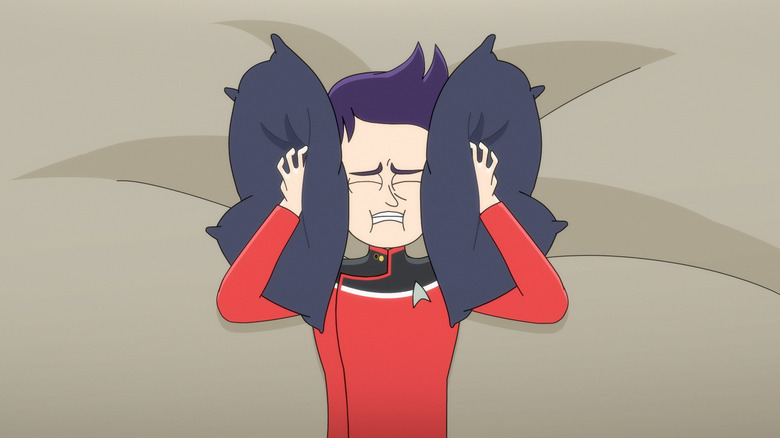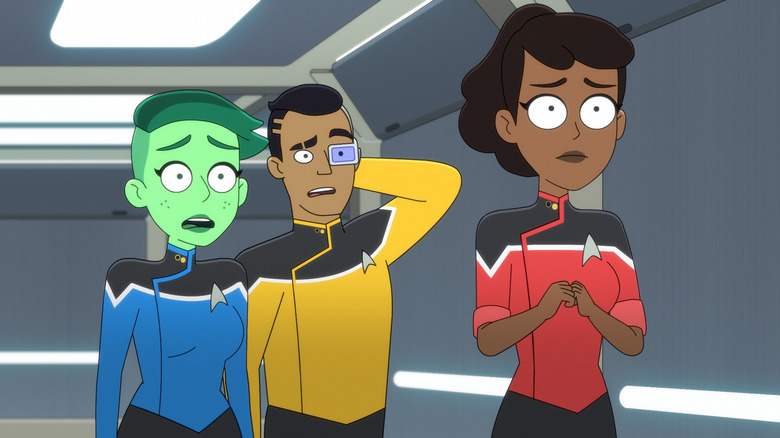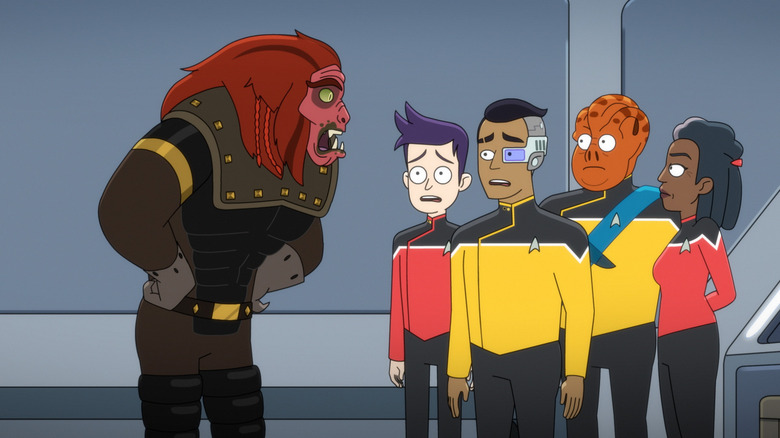Every Episode Of Star Trek: Lower Decks Has To Follow The Same Key Rule
At the beginning of the fourth season of "Star Trek: Lower Decks," Ensigns Mariner (Tawny Newsome), Boimler (Jack Quaid), Tendi (Noël Wells), and Rutherford (Eugene Cordero) were all promoted to Lieutenant, Junior Grade. This meant that each of them now had the ability to give orders to the remaining ensigns on the U.S.S. Cerritos and were afforded the privilege of private quarters. As ensigns, they had to sleep on bunks in a hallway and keep all their personal belongings inside tiny, drawer-like dressers embedded in the wall. There was no privacy. For the first time in their professional Starfleet careers, the four lead characters would be able to close a door behind them at the end of their shift.
But, in keeping with the spirit of the show, this isn't necessarily a net positive. In the episode "I Have No Bones, Yet I Must Flee," Boimler finds that there are some private quarters on the Cerritos that directly face the ship's massive, glowing engines. It's like having an apartment right next to a digital billboard or a blinking neon sign. When he tries bunking with his superior officer, Lieutenant Shaxs (Fred Tatasciore), he finds that the walls on the Cerritos are paper thin and that he can hear what people are up to in the next-door holodeck. The sexual sounds coming through the walls are unbearably disturbing.
Although Boimler has received a promotion, he is still a lower-ranking officer and his life is still difficult. This is the central joke — and the title's meaning — of "Lower Decks." These people will always occupy a low rung.
In an interview with ScreenRant, "Lower Decks" supervising director Barry J. Kelly noted that the show's beleaguered quality is a key guideline when writing stories.
Lower decks on other ships
Also notable: The second season of "Lower Decks" featured an episode called "wej Duj," which examined the "lower decks" of other alien ships. A segment on board a Klingon vessel depicted what life was like for lower-ranking officers in that alien culture. Ditto for a Vulcan vessel. It seems that being at the tail end of the chain of command isn't very romantic no matter what species you belong to. The fourth season of "Lower Decks" has been following a season-long plot thread wherein a mysterious unidentified vessel has been attacking various ships throughout the galaxy, and audiences have visited various starships to see what their "lower decks" life is like before they are blasted out of the heavens.
Kelly wanted to note that "Lower Decks" is not about the central heroes of the "Star Trek" universe but about the ones who work the crap jobs. Most of the other Trek shows to date have been about heroes and celebrities. It was vital to make sure that the four lead characters on "Lower Decks" weren't the ones in charge. Kelly said:
"[W]e're doing something different than other episodes. You would still understand, I think, that the show is called 'Lower Decks' and that we're looking at the lower decks of another spaceship, even if it's not the Cerritos. You will get that there is a fun viewpoint and looking at that perspective on any ship. There's a TV show going on with the captains and all the heroes (quote, unquote), but there's also a TV show for the people below. The 'Downton Abbey' of sci-fi shows, that's what we're going for. Don't tell Mike I said that."
"Mike" being Mike McMahan, the show's creator. Who, it seems, has an aversion to "Downton Abbey."
Clarity is key
Kelly also noted his personal mandate toward clarity, a quality that many Trekkies will appreciate. One of the more appealing aspects of "Star Trek" is its technical detail. A lot of time and effort goes into making the franchise's imaginary technology sound scientifically possible. Trekkies have the impression that starship engines are massively complicated and require a team of a hundred people to keep operational. If one pays close attention, one could even suss out which buttons on a bridge computer panel operate a starship's specific functions.
Kelly wants to keep the property's tactile, button-pushing quality intact on "Lower Decks" as a way of spelling out to potential neophytes how everything works. He noted:
"The beauty of our characters is if you drop into an episode, you can just pick up who's who right away. In my mind's eye, from the director's standpoint, when I'm working with our directors, is that I still want to make something that [works for] first-time viewers. Even if it's episode 9 of season 3, I'm like, 'Do they know what a phaser does? Maybe I should just set up that you gotta press a button to shoot it.' Little things like that. Maybe it's like an old-school Marvel Comics way of thinking, but you always want something to set up new people to come in, and be an entry point."
The Marvel Comics quality Kelly refers to is the tendency for comics writers to add small explanatory captions into the margins, making sure any new readers know where they stand. Spider-Man might make mention of his web-shooters, for instance, and a small yellow narrative box will spell out something like "THE WEB-SLINGING DEVICES THAT PETER PARKER BUILT HIMSELF! SEE ISSUE #1!"
The clarity is deeply appreciated.


